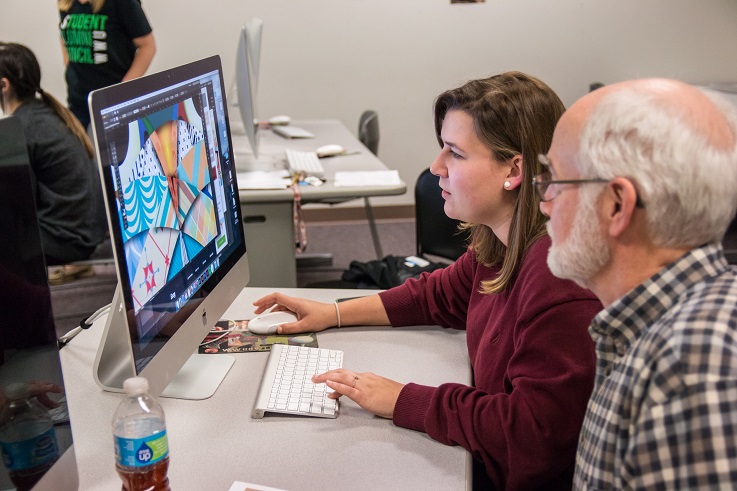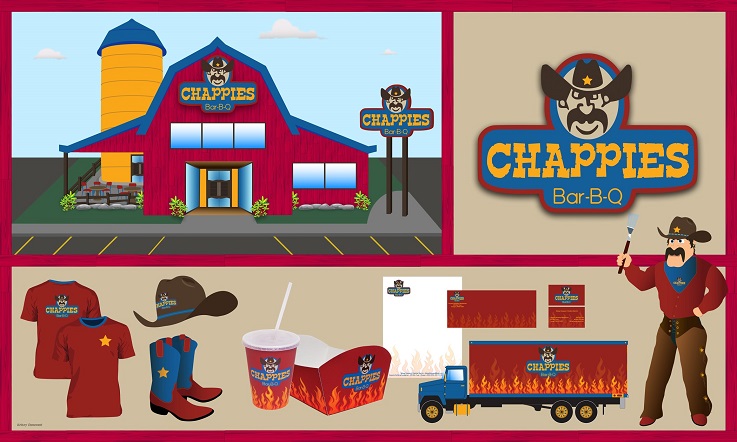Tips for graphic design majors on preparing your portfolio for a job interview

Bachelor of graphic design students know that preparing your portfolio is one of the most important things you will do during your undergraduate career. Your portfolio will become a critical element of how employers evaluate your candidacy for a particular position.
Throughout your coursework at William Woods University, you’ll have an opportunity to design various pieces with the guidance of faculty who will impart their knowledge and industry experience to help you hone your skills and create work you’ll be proud of. In addition to the advice and mentorship you’ll receive from your professors, below we’ve put together a few tips from various industry experts that can help you prepare your portfolio for a job interview.
1. Use your best work. A recent Artrepreneur article shares the advice of Brian Young, a lead recruiter at Creative Circle, who recommends showing only your best and most recent work. This may be particularly challenging for students who do not have a lot to choose from. However, for college seniors or recent graduates, a portfolio of eight to 12 examples of your best work offers enough substance and range to show off your skills, style and creativity.
 Hunter Nesbitt, ’07, Artist, Los Angeles, Ca.
Hunter Nesbitt, ’07, Artist, Los Angeles, Ca.
2. Practice talking about your work. An ability to talk confidently about your work and the process you undertook to get to a final product is very valuable. A Creative Bloq article explains that talking through your process allows for a better understanding of your technique, even if the style of a particular piece may not be in line with what the employer is looking for. You can practice presenting your portfolio to a friend to boost your confidence or prepare for an interview.
 Emily Rodgers, ’16, Publication Specialist, Missouri Botanical Gardens, St. Louis, Mo.
Emily Rodgers, ’16, Publication Specialist, Missouri Botanical Gardens, St. Louis, Mo.
3. Get feedback. You are likely to receive valuable feedback from your professors throughout your undergraduate career that will ultimately shape and help refine your portfolio. However, you can also take advantage of portfolio reviews offered by organizations such as the American Institute for Graphic Artists (AIGA). AIGA’s portfolio reviews offer college students an opportunity to practice presenting their work to receive valuable feedback.
 Robin Powell, ’16, Graphic Retoucher, Southern Graphics Systems, Inc., St. Louis, Mo.
Robin Powell, ’16, Graphic Retoucher, Southern Graphics Systems, Inc., St. Louis, Mo.
4. Think about the format. Whether your portfolio is in a digital or print format or a combination of the two, a few of the same rules apply. Steff Geissbuhler, a celebrated designer of integrated brand and corporate identity programs, shares in his AIGA article that a well-structured portfolio, regardless of format, is well-organized, with a clear beginning, middle and an end. It should be easy to open, review and navigate. For example, if you are showing printed work, it may help to show work in full size.
 Kelsey Dunavant Harris, ’13, Designer, State of Missouri, Jefferson City, Mo.
Kelsey Dunavant Harris, ’13, Designer, State of Missouri, Jefferson City, Mo.
5. Highlight results. Whenever possible, try to highlight the impact your work has created. For example, if you’ve worked on a series of posters to promote a campus event, share how your project has influenced the overall event attendance. An award-winning graphic designer Karen DeFelice writes, “If you designed a marketing campaign, it’s great to include who else worked on the project, how they measured results and how successful it was.”
 Jessica Bargate Pelzer, ’12, Creative Director, Bucket Media, Columbia, Mo.
Jessica Bargate Pelzer, ’12, Creative Director, Bucket Media, Columbia, Mo.
6. Create work you wish to show off. As a graphic design student, you may have limited number of pieces to show off from your class projects or internship experiences. However, Alec McGuffey, a co-founder of RookieUp recommends simply creating the work that’s missing in your portfolio. “A great way to find inspiration for new projects is to think about some problems that bother you and design solutions for those problems.”
 Wall of student photos from a recent William Woods University Senior Art Show exhibit.
Wall of student photos from a recent William Woods University Senior Art Show exhibit.
7. Share a bit about you. If you are creating a digital portfolio, you’ll likely have an About page. Use this section of the site to share more distinctive elements that help your portfolio and you stand out. A 99U article by Mell Ravenel suggests, “Personalize your about page to tell your story, not just list your past projects.” This may include mentioning any awards you may have won such as school competitions or adding a link to a current blog, if you have one.

8. Update your portfolio over time. A portfolio is an evolving representation of your best work so it’s important that you take the time to update it regularly. For example, if you’ve developed a portfolio for your internship interview in junior year, you’ll want to update it before graduation to ensure it reflects your internship experience and any work you may have done during senior year coursework.
 Jamie Lanagan, ’14, Teacher, Brooklyn, N.Y.
Jamie Lanagan, ’14, Teacher, Brooklyn, N.Y.
At William Woods University, students earning a bachelor’s degree in graphic design will take ART 210 – Portfolio Development. This course will introduce students to the importance, concept, and production of a professional art portfolio. Students will create
both a conventional and an electronic portfolio of their work that they can continue to update and refine as they create various pieces throughout their coursework.

